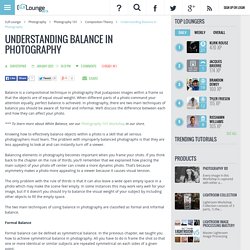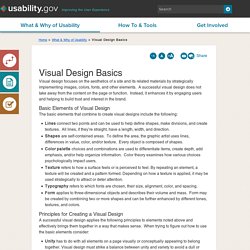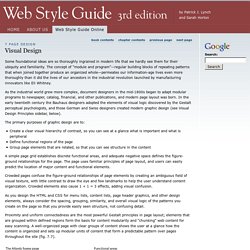

Understanding Balance in Photography. Balance is a compositional technique in photography that juxtaposes images within a frame so that the objects are of equal visual weight.

When different parts of a photo command your attention equally, perfect balance is achieved. In photography, there are two main techniques of balance you should be aware of: formal and informal. We’ll discuss the difference between each and how they can affect your photo. *** To learn more about White Balance, see our Photography 101 Workshop in our store.
Knowing how to effectively balance objects within a photo is a skill that all serious photographers must learn. Balancing elements in photography becomes important when you frame your shots. The only problem with the rule of thirds is that it can also leave a wide open empty space in a photo which may make the scene feel empty. Visual Principles of Web Design. The design of your website is more important for conversions than you think.

You can implement any conversion boosting tactic in the world, but if it looks like crap, it won’t do you much good. Design is not just something designers do. Design is marketing. Design is your product and how it works. The more I’ve learned about design, the better results I’ve gotten. Here are 8 effective web design principles you should know and follow. Note: ConversionXL Institute is where the top 1% of marketers learn their craft. Effective Web Design Principle #1: Visual Hierarchy Squeaky wheels get the grease and prominent visuals get the attention. Exercise. Without knowing ANYTHING about these circles, you were easily able to rank them.
Certain parts of your website are more important than others (forms, calls to action, value proposition etc), and you want those to get more attention than the less important parts. Hierarchy does not only come from size. Start with the business objective. Visual Design Basics. Visual design focuses on the aesthetics of a site and its related materials by strategically implementing images, colors, fonts, and other elements.

A successful visual design does not take away from the content on the page or function. Instead, it enhances it by engaging users and helping to build trust and interest in the brand. Basic Elements of Visual Design The basic elements that combine to create visual designs include the following: Lines connect two points and can be used to help define shapes, make divisions, and create textures. Principles for Creating a Visual Design A successful visual design applies the following principles to elements noted above and effectively brings them together in a way that makes sense. Unity has to do with all elements on a page visually or conceptually appearing to belong together. Example of Pulling it all together Additional Information. Visual Design. Some foundational ideas are so thoroughly ingrained in modern life that we hardly see them for their ubiquity and familiarity.

The concept of “module and program”—regular building blocks of repeating patterns that when joined together produce an organized whole—permeates our information-age lives even more thoroughly than it did the lives of our ancestors in the industrial revolution launched by manufacturing innovators like Eli Whitney. As the industrial world grew more complex, document designers in the mid-1800s began to adapt modular programs to newspaper, catalog, financial, and other publications, and modern page layout was born. In the early twentieth century the Bauhaus designers adopted the elements of visual logic discovered by the Gestalt perceptual psychologists, and those German and Swiss designers created modern graphic design (see Visual Design Principles sidebar, below). The primary purposes of graphic design are to: Consistency Contrast. What Makes Good (Visual) Design? The wide availability of visual tools both online and offline has made it quite easy to create homemade graphic designs.

Today, more and more freelancers and non-professional designers are using visual tools to jump start a career in graphic design. If you’re looking to improve your understanding of design and its creation, then read on. This blog post will not only delve into the details of the basic elements of design, it will go further by explaining the principles of how elements should be put together to create an entertaining and amusing visual project for yourself and your client.